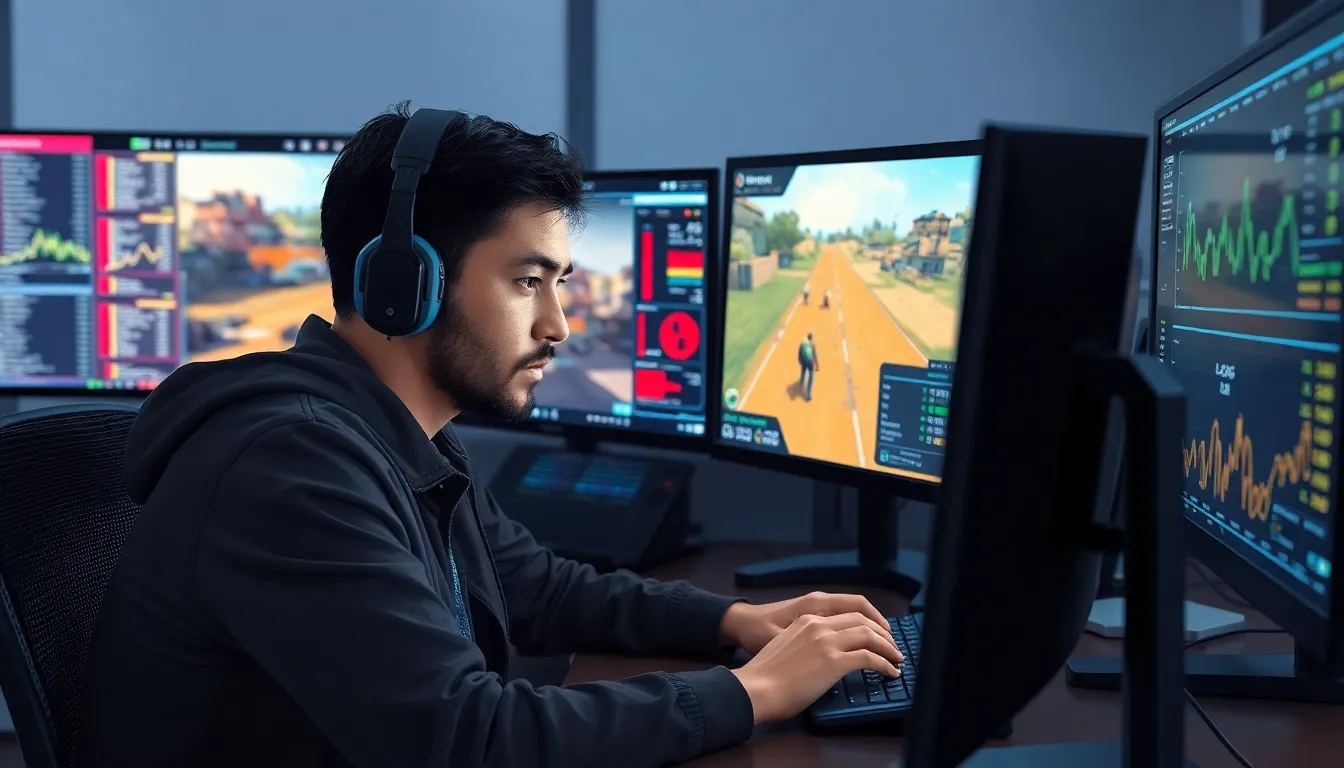Table of Contents
ToggleIn the fast-paced world of competitive gaming, where every millisecond counts and strategy reigns supreme, understanding the nuances of gameplay can mean the difference between victory and defeat. Players aren’t just mashing buttons; they’re executing complex tactics that rival the most intricate chess matches. If you think it’s just a bunch of kids in their pajamas, think again—this is serious business.
Overview of Competitive Gaming Analysis
Competitive gaming analysis involves examining the strategies and dynamics of esports. This analysis plays a crucial role in helping teams and players enhance their performance.
Definition and Importance
Competitive gaming analysis refers to the systematic evaluation of gameplay elements. Analyses encompass player statistics, gameplay patterns, and in-game decision-making processes. Insights gained from this analysis help identify strengths and weaknesses in performance. Understanding these aspects allows teams to improve strategies, refine skills, and adapt to opponents. In a rapidly evolving landscape, staying ahead of trends becomes vital. Successful teams leverage in-depth analysis to gain a competitive edge.
Key Components of Analysis
Key components of competitive gaming analysis include data collection, performance metrics, and strategy assessment. Data collection captures in-game actions and outcomes, facilitating a broad view of player engagement. Performance metrics provide quantifiable data that includes kill/death ratios, accuracy rates, and team objectives. Strategy assessment involves reviewing gameplay footage to analyze decision-making and tactical execution. Each component contributes to a comprehensive understanding of gameplay dynamics. Therefore, maintaining focus on these critical areas becomes essential for achieving and sustaining success in competitive gaming.
Techniques in Competitive Gaming Analysis

Competitive gaming analysis employs various techniques that enhance player performance and strategy. Data-driven methods form the foundation of successful assessments.
Data Collection Methods
Numerous data collection methods support competitive gaming analysis. Players and teams capture in-game statistics using software tools. These include tracking individual actions, character movements, and team dynamics. Observational techniques also play a role, with analysts recording gameplay footage for review. In addition, surveys or interviews with players provide qualitative insights into decision-making processes. Effective data collection combines quantitative and qualitative approaches, fostering a comprehensive understanding of gameplay.
Performance Metrics and Evaluation
Performance metrics reveal crucial insights into player efficiency. Common metrics include kill-to-death ratios, objectives completed, and match win percentages. Analysts evaluate these figures to gauge individual and team effectiveness. Furthermore, tracking trends over time highlights improvements or skill gaps. Teams often use benchmarking against top players or competitors to set performance standards. By assessing these metrics, gamers can identify specific areas for development, ultimately leading to enhanced success in competitive environments.
Tools and Software for Analysis
Competitive gaming analysis utilizes various tools and software to enhance player performance and strategy. These resources play a crucial role in streamlining data collection and evaluation.
Popular Tools in the Industry
Several tools stand out in the competitive gaming analysis landscape. Twitch, used for live-streaming gameplay, allows players to analyze their performance through audience feedback. Overwolf offers in-game overlays that capture essential statistics while players compete. Discord serves as a communication platform for teams, empowering analysts to discuss strategies in real time. Mobalytics breaks down individual performance metrics, providing insights on improvement areas. Esports Analytics helps organizations track player data across multiple matches, enabling strategic planning.
Benefits of Using Analytical Software
Integrating analytical software into competitive gaming offers significant advantages. Enhanced data accuracy leads to improved player assessments and strategic decisions. These tools provide detailed performance metrics, helping identify specific strengths and weaknesses. Time-saving capabilities allow analysts to focus efforts on high-impact areas. Real-time feedback enables immediate adjustments to tactics during matches. Overall, effective use of analytical software promotes informed gameplay, fostering higher levels of success in competitive environments.
Case Studies in Competitive Gaming
Case studies provide valuable insights into the dynamics of competitive gaming. They highlight successful strategies and the lessons teams learn from both victories and defeats.
Success Stories
Successful teams often utilize insightful analysis to gain a competitive edge. For example, Team SoloMid (TSM) achieved significant victories by focusing on data analytics and individual player metrics. Their use of tools like Mobalytics allowed them to fine-tune strategies based on performance metrics. Similarly, Fnatic leveraged gameplay footage to develop team cohesion and enhance communication. These approaches resulted in improved teamwork and higher win rates. Victory in tournaments often reflects the effective use of competitive gaming analysis, showcasing the blend of analytical rigor and gameplay mastery.
Lessons Learned from Failures
Failures in competitive gaming provide essential learning opportunities. For instance, Team Dignitas encountered challenges during their early seasons due to a lack of strategic analysis on opponent playstyles. Their inability to adapt led to unforeseen losses. By analyzing these defeats, they identified weaknesses in their approach to team composition and gameplay tactics. Consequently, they restructured their training regimen to emphasize adaptability in strategies. Many teams, like Cloud9, have experienced similar setbacks, which prompted critical shifts in their analysis methods. This proactive approach to learning from mistakes often positions teams for future success in high-stakes environments.
Future Trends in Competitive Gaming Analysis
Competitive gaming analysis is evolving rapidly, driven by advancements in technology and strategies. This evolution shapes how teams train, optimize performance, and compete.
Emerging Technologies
Artificial intelligence offers innovative tools for analyzing gameplay patterns. Machine learning algorithms can evaluate vast amounts of data, revealing insights that human analysts might overlook. Cloud computing enhances accessibility to performance metrics and analysis tools, allowing teams to collaborate seamlessly across geographical boundaries. Furthermore, augmented reality and virtual reality are transforming training environments, providing immersive experiences that simulate live competition. These technologies enable players to practice under pressure and refine their skills effectively.
Evolving Strategies
Agile methodologies are gaining traction among competitive gaming teams. These strategies emphasize flexibility and adaptability in response to evolving opponent tactics. Data-driven approaches guide decision-making, enabling teams to adjust strategies in real-time during competitions. Additionally, incorporating feedback loops into training helps players identify weaknesses and strengths more swiftly. Team synergy remains crucial; fostering communication and trust directly impacts overall performance. As teams adopt these evolving strategies, the potential for enhanced gameplay success increases substantially.
Conclusion
The landscape of competitive gaming is evolving rapidly. As players and teams harness the power of data analysis and innovative tools they’re redefining their approach to strategy and performance. Embracing both quantitative and qualitative insights fosters a deeper understanding of gameplay dynamics.
Success hinges not only on skill but also on the ability to adapt and learn from both victories and setbacks. The integration of emerging technologies promises to further enhance competitive gaming analysis, paving the way for new strategies and improved performance.
Ultimately, those who commit to rigorous analysis and continuous improvement will find themselves at the forefront of this dynamic arena.




